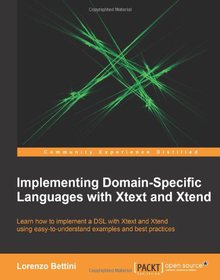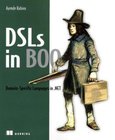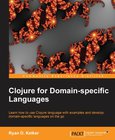Implementing Domain-Specific Languages with Xtext and Xtend

Book Details:
| Publisher: | Packt Publishing |
| Series: | Packt |
| Author: | Lorenzo Bettini |
| Edition: | 1 |
| ISBN-10: | 1782160302 |
| ISBN-13: | 9781782160304 |
| Pages: | 342 |
| Published: | Aug 21 2013 |
| Posted: | Nov 19 2014 |
| Language: | English |
| Book format: | |
| Book size: | 10.4 MB |
Book Description:
Learn how to implement a DSL with Xtext and Xtend using easy-to-understand examples and best practices Overview Learn to quickly develop a domain-specific language with Xtext Implement any aspect of a DSL using Xtend, a fully featured Java-like programming language Discover how to test a DSL implementation and how to customize runtime and IDE aspects of the DSL In Detail Xtext is an open source Eclipse framework for implementing domain-specific languages together with its IDE functionalities. It lets you implement languages really quickly, and, most of all, it covers all aspects of a complete language infrastructure, starting from the parser, code generator, interpreter, and more. "Implementing Domain-Specific Languages with Xtext and Xtend" will teach you how to develop a DSL with Xtext, an Eclipse framework for implementing domain-specific languages. The chapters are like tutorials that describe the main concepts of Xtext such as grammar definition, validation, code generation, customizations, and many more, through uncomplicated and easy-to-understand examples. Starting with briefly covering the features of Xtext that are involved in a DSL implementation, including integration in an IDE, the book will then introduce you to Xtend as this language will be used in all the examples throughout the book. We then proceed by explaining the main concepts of Xtext, such as validation, code generation, and customizations of runtime and UI aspects. By the end of the book, you will have learned how to test a DSL implemented in Xtext with Junit, in order to follow a test-driven development strategy that will help the developer implement maintainable code that is much faster and cleaner. A test-driven approach is used throughout the book when presenting advanced concepts such as type checking and scoping. The book also shows you how to build and release a DSL so that it can be installed in Eclipse, and gives you hints on how to build the DSL headlessly in a continuous integration server. "Implementing Domain-Specific Languages with Xtext and Xtend" aims to complement the official Xtext documentation to explain the main concepts through simplified examples and to teach the best practices for a DSL implementation in Xtext. It is a Beginners Guide which should set you up for professional development DSL and its Eclipse IDE tooling. What you will learn from this book Learn to write an Xtext grammar for a DSL Use Xtend as an alternative to Java to write cleaner, easier-to-read, and more maintainable code Write constraint checks for a DSL using the validator mechanism Learn how to write a code generator and an interpreter for a DSL Discover how automatic symbol resolution works in Xtext and how to customize it Build and deploy a DSL implementation so that others can install it Get well versed with the typical Xtext development workflow Approach A step-by-step guide that enables you to quickly implement a DSL with Xtext and Xtend in a test-driven way with the aid of simplified examples.
Download Link:
Related Books:
DSLs in Boo
Domain Specific Languages in .NET
A general-purpose language like C# is designed to handle all programming tasks. By contrast, the structure and syntax of a Domain-Specific Language are designed to match a particular applications area. A DSL is designed for readability and easy programming of repeating problems. Using the innovative Boo language, it's a breeze to create a DSL for your application domain that works on .NET and does not sacrifice performance.DSLs in Boo shows you how to design, extend, and evolve DSLs for .NET by focusing on approaches and patterns. You learn to define an app in terms that match the domain, and to use Boo to build DSLs that generate efficient executables. And you won't deal with the awkward XML-laden syntax many DSLs require. The book concentrates on w...
Clojure for Domain-specific Languages
Learn how to use Clojure language with examples and develop domain-specific languages on the go Overview Explore DSL concepts from existing Clojure DSLs and libraries Bring Clojure into your Java applications as Clojure can be hosted on a Java platform A tutorial-based guide to develop custom domain-specific languages In Detail Clojure is a very new and rapidly growing language that runs on top of the JVM. The language being hosted on the Java platform allows for Clojure applications to use existing Java components. Although there are objects in Clojure, the language is not object oriented. "Clojure for Domain-specific Languages" is an example-oriented guide to building custom languages. Many of the core components of Clojure are covered...
Domain - Specific Languages
When carefully selected and used, Domain-Specific Languages (DSLs) may simplify complex code, promote effective communication with customers, improve productivity, and unclog development bottlenecks. In Domain-Specific Languages, noted software development expert Martin Fowler first provides the information software professionals need to decide if and when to utilize DSLs. Then, where DSLs prove suitable, Fowler presents effective techniques for building them, and guides software engineers in choosing the right approaches for their applications. This books techniques may be utilized with most modern object-oriented languages; the author provides numerous examples in Java and C#, as well as selected examples in Ruby. Wherever possible, chapters are or...
2007 - 2021 © eBooks-IT.org



